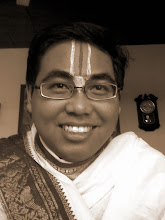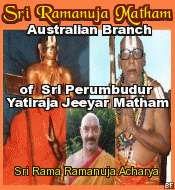 His Revered Holiness The 45th Alakkhiya Singhar (Throne-holder and Pontiff) of Ahobhila Math bestowed Vaishnavite initiation to these devotees
His Revered Holiness The 45th Alakkhiya Singhar (Throne-holder and Pontiff) of Ahobhila Math bestowed Vaishnavite initiation to these devoteesAfter accepting the divine sacrament of five-fold Vaishnavite practices as recommended in The Vedas and Vaishnava-agamas, he was not belong to any caste or varna; Brahmins, Ksatriyas, Vaisyas, Sudras, or outcastes. He came to take ekanta dasyatva – exclusive servitor-ship and honored as saranagata or prapanna – a surrendered companion of The Lord’s own family. He wouldn’t identified himself with his blood-relationship based mundane family linage any more. He takes a broader, universal fraternity of all Lord Vishnu’s servants or the Bhagavatas and Vaishnavas. In Nusantara, this gotra also called Hari-vansha or Hariwangsa.
The Hariwangsas in the true sense were identified not according to their blood-tie-relationship, but based on their ability to continue the teachings and practices of their ancestor. Some family lineages who traced their origin in East Java Kadiri’s nobilities, commonly accepted as Hariwangsa. Their descendants were still living in Bali today, with very complicated historical backgrounds. We have no other source to determine their true relations than the Babads (Family Chronicles, but full of what we think as mythological stories) and some official inscriptions, issued by previous generations. (Some were written on chopper tablets but many more on just palm-leaf manuscript, easily damaged by weather, age, etc.)
You may still remember the Markandeya Rishi of Java who came to Bali as the founder of Vaishnavite Brahmin lineage of Bali and established the civilized society. The Chronicles of Markandeya Rishi’s lineage, the Bhujanga Vaishnava Brahminical order, was begun with invocation to The Lord.
Om namah devaya, panamaskaraning hulun i bhatara hyang mami. Sadnya paduka bhatara wishnu, sira anugrahaning bhukti mwang mukti, siddha saprayojana, nitya pratistheng urddha siwadwara sembahen. Iti tattwanira ida bhujangga waishnawa haneng bali pulina, nguni kamimitanira saking jawa dwipa mandala, tumurun mareng bali dwipa mandala.
”Om namah devaya, I’m offering my most respectful obeisance unto my Glorious Lord. No other than that most worshipable Lord Vishnu, who bestows all bhukti (sensual pleasures) and mukti (the liberation), attained as our highest ultimate goal, continuously worshiped and enthroned eternally on the crown of our head. This is the truth about how the revered Bhujanga Vaishnavas exist in the Island of Bali. On the past, their origin was from Java and then descended to Bali.”
Thus, the Bhujanga Vaishnava lineage of Bali was an Achyuta Gotra who practices Vedic brahminical duties and performed the Vaishnavite Tantric or Agamic sadhanas (spiritual disciplines) and simultaneously also protects the continuation the disciplic succession. Though today it is difficult to differentiate them from other Balinese priestly orders (or sects), but by observing and listening to their prayers we will find many Vaishnavite formulas. If today they might be became like the Smarta Brahmins of India, at least their Istha-deva is Lord Sriman Narayana. Such changes were not uncommon. As an example, some Vadama Smartas of South India, by influence of Sri Ramanuja’s preaching work, have become Vaishnavite Iyengar Brahmins, so did the Vaishnava Brahmins of Bali. Some have accepted other sect’s sadhanas by their long association with them. But many exclusive Vaishnavite mantras and sadhanas still exist in their community.
Gajamada, the greatest personage, legendary prime minister, and may be the most powerful personality ever, who unified the whole Nusantara for the first time under one flag of Bilvatikta (Majapahit). Verily, he was the person who became the first founder of our Nation, which now called Indonesia. The Gajamada inscription told us that he was part of Acyuta Gotra. That means he took pancasamskara diksha or came from the family whose ancestors already take Vaishnava-pancasamskara-diksha (tusning Waisnawakula sira Dwirada Mada wangsa). Waisnawakula or Vaishnava-kula has the same meaning with Acyuta Gotra or Hariwangsa, and Dwirada was considered as Gajamada’s actual name (Gajamada means a mad elephant, indicating his powerful prowess, as strong as a mad elephant on the battle).
The classical poems of Sundayana, described the departure of Gajamada. “After the wall of his official abode as a prime minister was broken apart (accepted as the sign of his time to leaves mundane life and the end of his official duty to the kingdom), the revered one applied his special attire. Wearing a set of white cloth, embroidered with gringsing (golden leafs) motifs and the belt of atma-raksi (used by a high priest). His brahminical thread (yajnopavita, sign of an ordained brahmin) shined on his shoulder and chest. He entered deep meditation, hold a mala (rosary) and chanted The Lord’s Holy Names. His hands were showing the mudras (mystical gestures). The great Mada then absorbed his consciousness in the most ultimate teachings. He left his physical mundane body dissolved in its natural substances. His True Self then ascended to the most glorious abode of Lord Narayana. Thus our great leader has left this mundane world and never seen anymore.”

 When the kingdom of Bali been subdued by Bilvatikta’s power under Gajamada’s command, a certain nobility called Sri Krishna was appointed by the Queen of Bilvatikta* to act as her representative in Bali. He was a descendant of Kadiri nobilities and Brahmin by caste. Sri Krishna ordained as a ruler of Bali in the name of Bilvatikta, and named Sri Krishna Kepakisan. Kepakisan means a nail, he was a “nailing force”, a pivot, to prevent Bali fall into chaotic condition after Bilvatikta’s invasion. But unfortunately, rebel movements were growing everywhere. In desperate heart Sri Krishna Kepakisan came back to Java and prepared to ask Queen’s permission to let him put his office. But Gajamada approached him and said, “Aywa cili atulaka… yan cili atulak dede i ngong Hariwangsa… Please don’t come back my son. You shouldn’t give up. Otherwise you were not a part of Hariwangsa. The Lord’s family has to done his duty and took his responsibilities.” Then it was said, the Gajamada gave him a kriss (bladelike traditional weapon), a replica of Lord Vishnu’s divine conch (it could be a rare Laksmi-sankha), and some Vaishnavite secret teachings to give him boldness, self confidence, and bring peace to Bali. (sing anaka ganja dungkul sungu si pancajanya bhusana aji kajanardanan, “I shall give you supplies my son, the divine pancajanya conch and ‘attire’ (bhusana) of the secret teaching of Lord Janardana, aji kajanardanan”).
When the kingdom of Bali been subdued by Bilvatikta’s power under Gajamada’s command, a certain nobility called Sri Krishna was appointed by the Queen of Bilvatikta* to act as her representative in Bali. He was a descendant of Kadiri nobilities and Brahmin by caste. Sri Krishna ordained as a ruler of Bali in the name of Bilvatikta, and named Sri Krishna Kepakisan. Kepakisan means a nail, he was a “nailing force”, a pivot, to prevent Bali fall into chaotic condition after Bilvatikta’s invasion. But unfortunately, rebel movements were growing everywhere. In desperate heart Sri Krishna Kepakisan came back to Java and prepared to ask Queen’s permission to let him put his office. But Gajamada approached him and said, “Aywa cili atulaka… yan cili atulak dede i ngong Hariwangsa… Please don’t come back my son. You shouldn’t give up. Otherwise you were not a part of Hariwangsa. The Lord’s family has to done his duty and took his responsibilities.” Then it was said, the Gajamada gave him a kriss (bladelike traditional weapon), a replica of Lord Vishnu’s divine conch (it could be a rare Laksmi-sankha), and some Vaishnavite secret teachings to give him boldness, self confidence, and bring peace to Bali. (sing anaka ganja dungkul sungu si pancajanya bhusana aji kajanardanan, “I shall give you supplies my son, the divine pancajanya conch and ‘attire’ (bhusana) of the secret teaching of Lord Janardana, aji kajanardanan”).(*At that time the lord of Bilvatikta was a queen, Sri Maharani Tribhuvana Vijayottungadevi, considered as an amsha (partial manifestation) of Mahalaksmi, the divine consort of Lord Vishnu. She was the Throne-holder after the death of her step brother king Jayanagara in one rebellion against the throne. Gajamada served both the Queen and also her son Sri Maharaja Rajasanagara or Hayam Wuruk or Bhre Hyang Wekasing Suksma. Gajamada began his political carrier as the captain of Bhayangkaras, exclusive troop of the Throne-holder and Royal Heir protectors. He was promoted after his success in guarding the Royal Heir from rebellion of Kuti, one of Dharmaputras, a troop supposed to guard the inner part of the palace, organized and controlled by rebellious minister Pati. But Kuti betrayed even his own master and want to take the throne for himself. Jayanagara the present king at that time and step brother of the next queen was murdered cleverly by the royal physician, Tancha, in so called medical operation of his tumor. Gajamada finally was again promoted as Prime Minister, the first highest office directly under the king, by the retired Prime Minister before him. This is because his great merit to the Kingdom by destroyed the powerful Sadeng rebellion. In case of Sri Maharani herself, she was the oldest daughter of Rajapatni Sri Gayatridevi. Sri Gayatridevi was not a prime queen of His Majesty the late king Kritarajasa Jayavardhana, the founder of Bilvatikta. The prime queen was Sri Tribhuvanadevi, the mother of Jayanagara. But Rajapatni Gayatridevi was famous as a very wise lady. She has spiritual competence in many sastric teachings and mystic practices (sadhanas). By the Javanese Buddhist at that time she was glorified as an emanation of Buddha Prajnaparamita and the Hindus honored her as an amsha of Bharatidevi or Sarasvati, the goddess of learning. Before Gajamada and his kings tried to spread Bilvatikta’s influence by politic and power, Rajapatni Gayatridevi was believed as the first lady who promoted the distribution of Bilvatikta’s knowledge and sacred wisdom, especially to Bali. That’s why the Balinese put her Puspa-samadhi in their mother temple of Besakih. Although Besakih actually was a symbol of Bali’s independency and this temple give the Balinese confidence, that they has no less position than Javanese nobility until this very day. But they take Rajapatni Gayatri in such a high regard, as the representative of the revered Hindu goddess of learning, Sri Sarasvatidevi herself. This could explain to us, verily knowledge is the true power in the world. (I shall describe how the protocol of worship in Besakih actually didn’t accept Javanese hegemony either politically or spiritually in other post).





.jpg)



































MY NAME IS TUMMKOMMA SUBHASH S/O GOPAL TUMMKOMMA CAST MITTHAL AYYAGAR (VAISHNO)
ReplyDeleteGHOTRA ACHUTA
Thank you for your visit and kind words. Please I beg you apologize since it is difficult for me to post a newer article. I am a little busy to prepare all these topics in book form.
ReplyDeleteAdiyen Dasanudasan
VR
My name is Adhikari Srikanta Dash. I am a retired Professor of Psychology. I now live in Bhubaneswar, Orissa/ Odisha, India. I belong to the 6th generation of the Vaishnava family of "Madhavacharya Sampradaya, Shyamananda Parivar, Achyuta Gotra", founded by Adhikari Bishwambhara Das at villange Langudi, Dist. Bhadrak, Orissa, India. My father, Adhikari Dayanidhi Das, was a devout Vaishnava well-versed in Sanskrit, Hindi, Bengali, and Oriya Vaishnava literature. Our family deity is Sri Sri Radha-Govinda. My elder bother, Swami Divyajeevanananda Saraswati is a direct disciple of Swami Chidananda Saraswati of The Divine Life Society, Rishikesh.
ReplyDeleteAfter my retirement as a Professor, I am now searching for the roots and branches of our Vaishnava traditions in India and abroad.
I found your Blog very interesting and enriching. I would like to maintain contact with you for further enriching and enlightening experiences. (a.srikanta.dash@gmail.com)